A Novel Multi-Objective Energy Management Strategy for Fuel Cell Buses Quantifying Fuel Cell Degradation as Operating Cost
Abstract
1. Introduction
- (1)
- This paper proposes a multi-objective cost function framework that can specifically quantify energy degradation as operating costs to represent the impact of energy degradation visually;
- (2)
- The effects of fuel cell power output fluctuation on the life and hydrogen consumption of a fuel cell/battery hybrid system were studied, and it was found that, the more stable the fuel cell power output, the smaller the life degradation of the fuel cell/battery hybrid system and the lower the operating cost;
- (3)
- Comparing real-world speed information with typical standard driving cycles, it is found that, in the real world, the working conditions change more drastically, the energy consumption is greater, and the smoother the fuel cell power output, the better the adaptability of the fuel cell system to complex working conditions.
2. System Model
2.1. Vehicle Dynamics Model
2.2. Fuel Cell Model
2.3. Battery Model
2.4. Multi-Objective Cost Framework
2.5. Constraints
3. Rule-Based EMS
3.1. Energy Management Strategy Rule Description
3.2. Verification of the Effectiveness of Energy Management Strategies
4. Simulation and Results
5. Conclusions
5.1. Main Finding
- (1)
- By setting different fuel cell output power limits, the influence of the fuel cell system output power fluctuations on hybrid systems is studied. The results show that the smaller the power control limit of the fuel cell system, that is, the more stable the fluctuation of the output power of the fuel cell system, the stronger the adaptability of the fuel cell system to complex working conditions, the more conducive it is to reduce the degradation of the fuel cell and extend the service life, thereby reducing the total operating cost;
- (2)
- Using the driving vehicle data collected from the 727 fuel cell bus in Zhengzhou, China, this was compared with the standard China city cycle. The results show that the fuel cell/battery hybrid system exhibits more operating characteristics than a typical standard driving cycle in real-world driving data, which shows the practical significance of using real-world data.
5.2. Future Work
Author Contributions
Funding
Institutional Review Board Statement
Informed Consent Statement
Data Availability Statement
Conflicts of Interest
References
- Das, H.S.; Tan, C.W.; Yatim, A.H.M. Fuel cell hybrid electric vehicles: A review on power conditioning units and topologies. Renew. Sustain. Energy Rev. 2017, 76, 268–291. [Google Scholar] [CrossRef]
- Lü, X.; Wu, Y.; Lian, J.; Zhang, Y.; Chen, C.; Wang, P.; Meng, L. Energy management of hybrid electric vehicles: A review of energy optimisation of fuel cell hybrid power system based on genetic algorithm. Energy Convers. Manag. 2020, 205, 112474. [Google Scholar] [CrossRef]
- Li, H.; Ravey, A.; N’Diaye, A.; Djerdir, A. Online adaptive equivalent consumption minimisation strategy for fuel cell hybrid electric vehicle considering power sources degradation. Energy Convers. Manag. 2019, 192, 133–149. [Google Scholar] [CrossRef]
- Lü, X.; Wang, P.; Meng, L.; Chen, C. Energy optimisation of logistics transport vehicle driven by fuel cell hybrid power system. Energy Convers. Manag. 2019, 199, 111887. [Google Scholar] [CrossRef]
- Hofman, T.; Steinbuch, M.; Van Druten, R.; Serrarens, A. Rule-based energy management strategies for hybrid vehicles. Int. J. Electr. Hybrid Veh. 2007, 1, 71–94. [Google Scholar] [CrossRef]
- Ravey, A.; Blunier, B.; Miraoui, A. Control strategies for fuel-cell-based hybrid electric vehicles: From offline to online and experimental results. IEEE Trans. Veh. Technol. 2012, 61, 2452–2457. [Google Scholar] [CrossRef]
- Shi, J.; Xu, B.; Shen, Y. Energy management strategy for battery/supercapacitor hybrid electric city bus based on driving pattern recognition. Energy 2022, 243, 122752. [Google Scholar] [CrossRef]
- Saiteja, P.; Ashok, B. Critical review on structural architecture, energy control strategies and development process towards optimal energy management in hybrid vehicles. Renew. Sustain. Energy Rev. 2022, 157, 112038. [Google Scholar] [CrossRef]
- Sun, H.; Fu, Z.; Tao, F. Data-driven reinforcement-learning-based hierarchical energy management strategy for fuel cell/battery/ultracapacitor hybrid electric vehicles. Power Sources 2020, 455, 227964. [Google Scholar] [CrossRef]
- Banvait, H.; Anwar, S.; Chen, Y. A rule-based energy management strategy for plug-in hybrid electric vehicle (PHEV). In Proceedings of the 2009 American Control Conference, St. Louis, MO, USA, 10–12 June 2009; pp. 3938–3943. [Google Scholar]
- Chen, Z.; Guo, N.Y.; Zhang, Q.; Shen, J.W.; Xiao, R.X. An optimised rule based energy management strategy for a Fuel Cell/Battery vehicle. In Proceedings of the 2017 IEEE Vehicle Power and Propulsion Conference (VPPC), Belfort, France, 11–14 December 2017; pp. 11–14. [Google Scholar]
- Trovão, J.P.; Pereirinha, P.G.; Jorge, H.M.; Antunes, C.H. A multi-level energy management system for multi-source electric vehicles—An integrated rule-based meta-heuristic approach. Appl. Energy 2013, 105, 304–318. [Google Scholar] [CrossRef]
- Thounthong, P.; Pierfederici, S.; Martin, J.P.; Hinaje, M.; Davat, B. Modeling and control of fuel cell/supercapacitor hybrid source based on differential flatness-control. IEEE Trans. Veh. Technol. 2010, 59, 2700–2710. [Google Scholar] [CrossRef]
- Wang, T.; Li, Q.; Chen, W.; Liu, T. Application of energy management strategy based on state machine in fuel cell hybrid power system. In Proceedings of the 2017 IEEE Transportation Electrification Conference and Expo, Asia-Pacific (ITEC Asia-Pacific), Harbin, China, 7–10 August 2017; pp. 1–5. [Google Scholar]
- Geng, B.; Mills, J.K.; Sun, D. Two-stage energy management control of fuel cell plug-in hybrid electric vehicles considering fuel cell longevity. IEEE Trans. Veh. Technology. 2011, 61, 498–508. [Google Scholar] [CrossRef]
- Fletcher, T.; Thring, R.H.; Watkinson, M.; Staffell, I. Comparison of fuel consumption and fuel cell degradation using an optimised controller. ECS Trans. 2016, 71, 85. [Google Scholar] [CrossRef]
- Liu, Y.; Li, J.; Chen, Z.; Qin, D.; Zhang, Y. Research on a multi-objective hierarchical prediction energy management strategy for range extended fuel cell vehicles. J. Power Sources. 2019, 429, 55–66. [Google Scholar] [CrossRef]
- Zhou, Y.; Ravey, A.; Péra, M.C. Multi-mode predictive energy management for fuel cell hybrid electric vehicles using Markov driving pattern recognizer. Appl. Energy 2020, 258, 114057. [Google Scholar] [CrossRef]
- Zhou, Y.; Li, H.; Ravey, A.; Péra, M.C. An integrated predictive energy management for light-duty range-extended plug-in fuel cell electric vehicle. J. Power Sources 2020, 451, 227780. [Google Scholar] [CrossRef]
- Ribau, J.P.; Silva, C.M.; Sousa, J.M.C. Efficiency, cost and life cycle CO2 optimisation of fuel cell hybrid and plug-in hybrid urban buses. Appl. Energy 2014, 129, 320–335. [Google Scholar] [CrossRef]
- Xu, L.; Mueller, C.D.; Li, J.; Ouyang, M.; Hu, Z. Multi-objective component sizing based on optimal energy management strategy of fuel cell electric vehicles. Appl. Energy 2015, 157, 664–674. [Google Scholar] [CrossRef]
- Chen, H.; Pei, P.; Song, M. Lifetime prediction and the economic lifetime of proton exchange membrane fuel cells. Appl. Energy 2015, 142, 154–163. [Google Scholar] [CrossRef]
- Fletcher, T.; Thring, R.; Watkinson, M. An Energy Management Strategy to concurrently optimise fuel consumption & PEM fuel cell lifetime in a hybrid vehicle. Int. J. Hydrog. Energy 2016, 41, 21503–21515. [Google Scholar]
- Hu, X.; Jiang, J.; Egardt, B.; Cao, D. Advanced power-source integration in hybrid electric vehicles: Multicriteria optimisation approach. IEEE Trans. Ind. Electron. 2015, 62, 7847–7858. [Google Scholar] [CrossRef]
- Xiong, R.; Pan, Y.; Shen, W. Lithium-ion battery aging mechanisms and diagnosis method for automotive applications: Recent advances and perspectives. Renewable and Sustainable Energy Reviews. 2020, 131, 110048. [Google Scholar] [CrossRef]
- Wang, J.; Liu, P.; Hicks-Garner, J.; Sherman, E.; Soukiazian, S.; Verbrugge, M.; Tataria, H.; Musser, J.; Finamore, P. Cycle-life model for graphite-LiFePO4 cells. J. Power Sources 2011, 196, 3942–3948. [Google Scholar] [CrossRef]
- Tang, L.; Rizzoni, G.; Onori, S. Energy management strategy for HEVs including battery life optimisation. IEEE Trans. Transp. Electrif. 2015, 1, 211–222. [Google Scholar] [CrossRef]
- Ebbesen, S.; Elbert, P.; Guzzella, L. Battery state-of-health perceptive energy management for hybrid electric vehicles. IEEE Trans. Veh. Technol. 2012, 61, 2893–2900. [Google Scholar] [CrossRef]
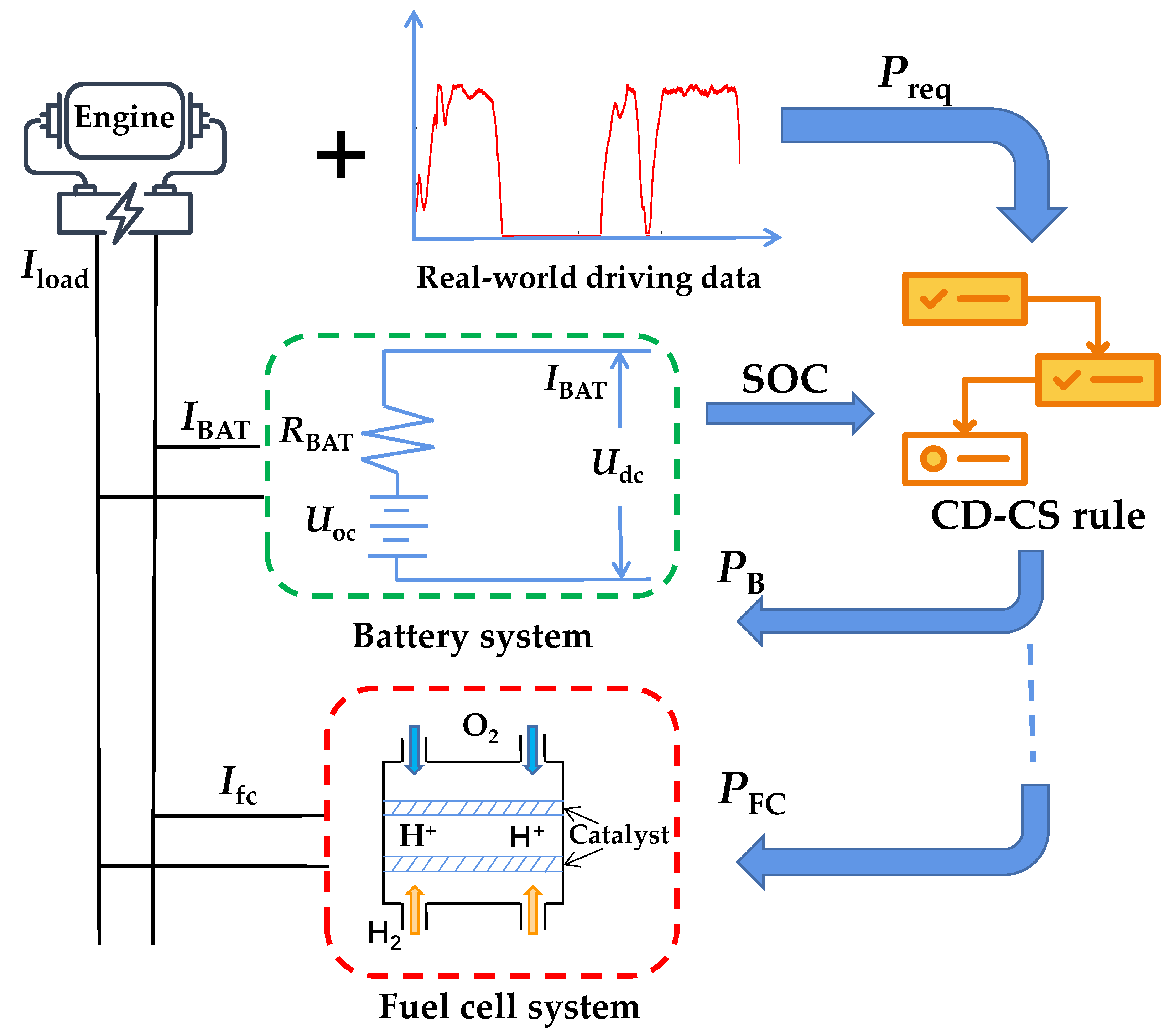
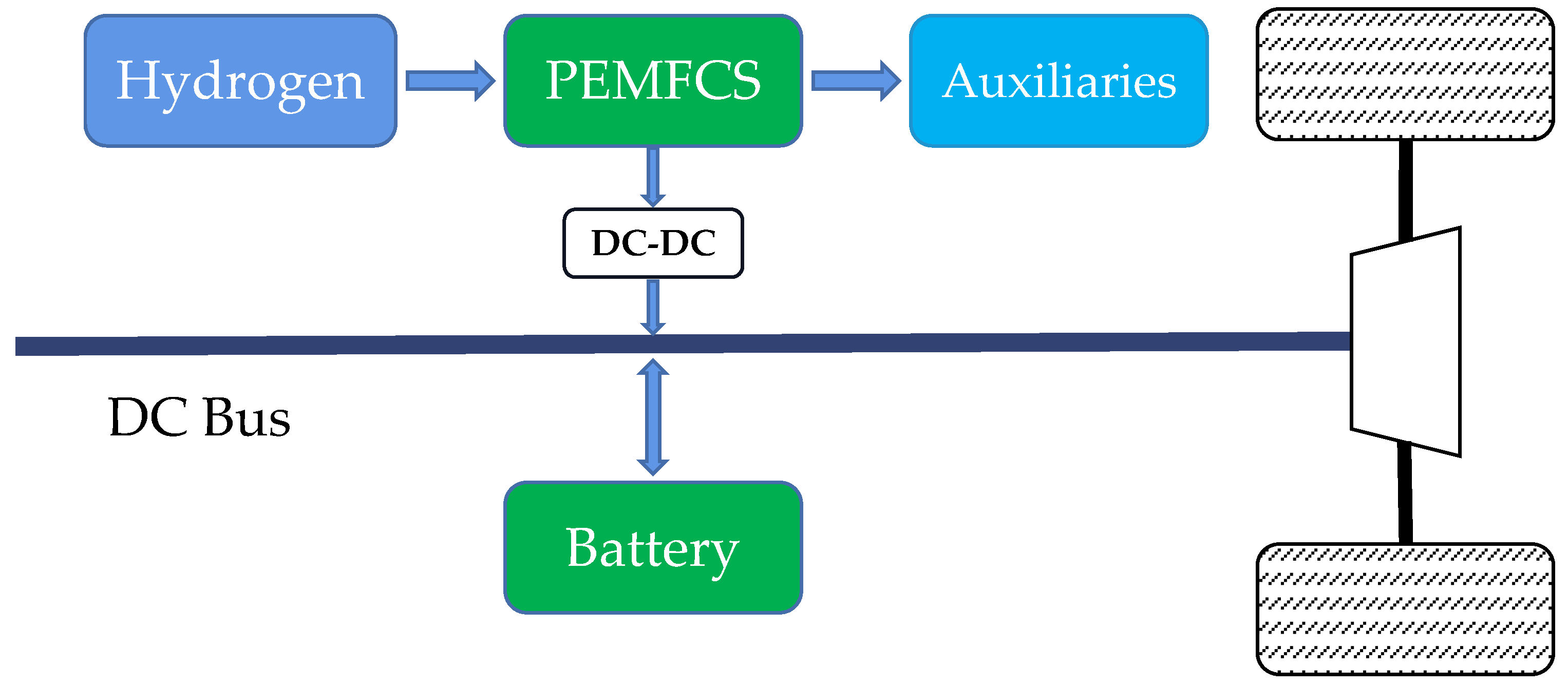
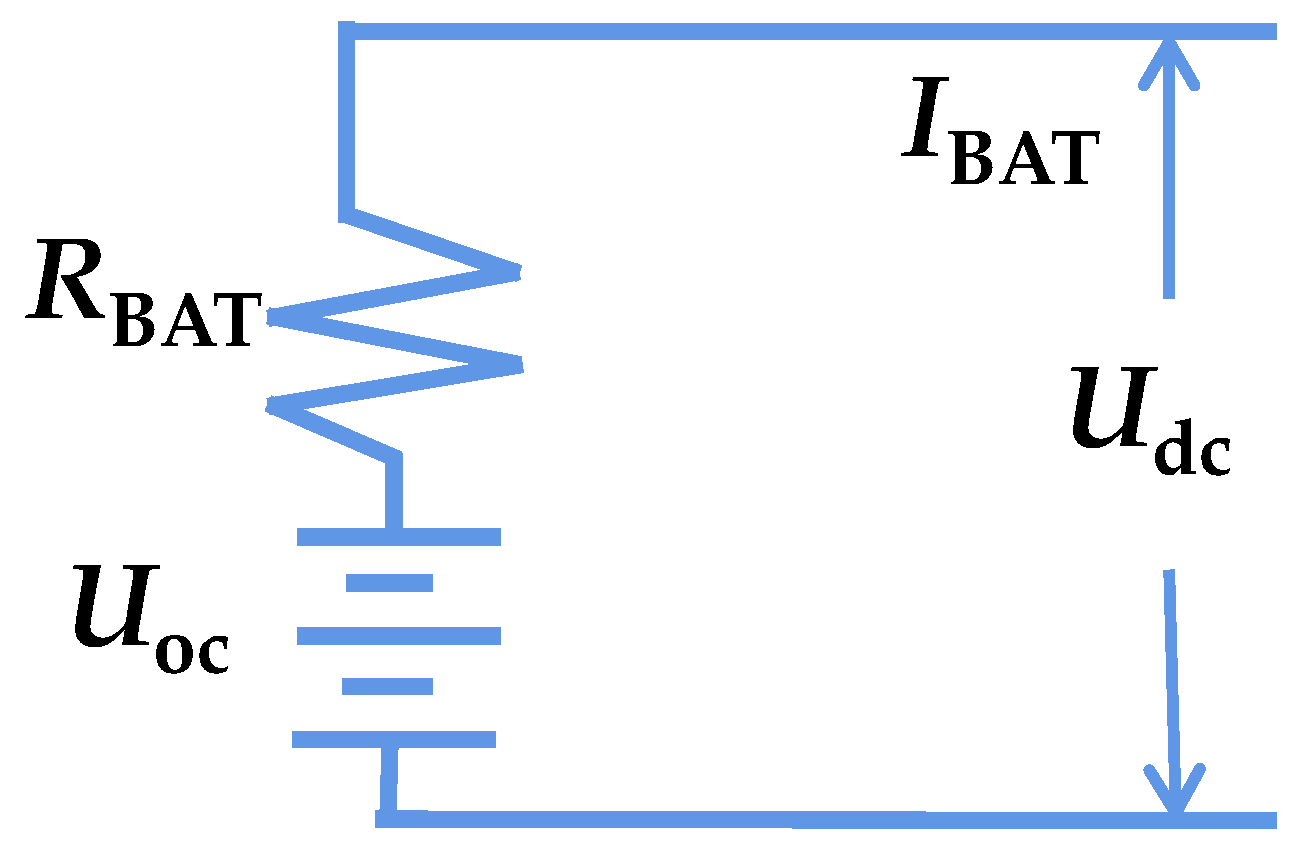
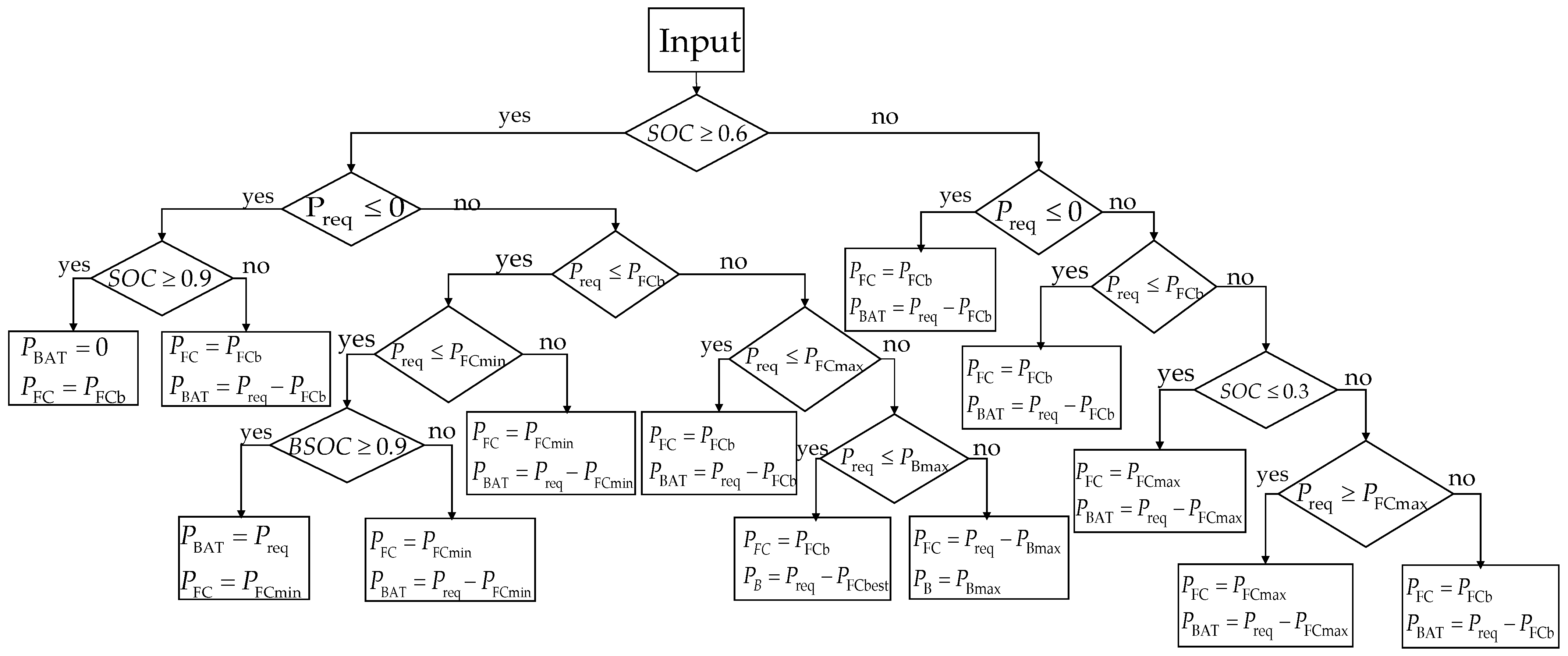
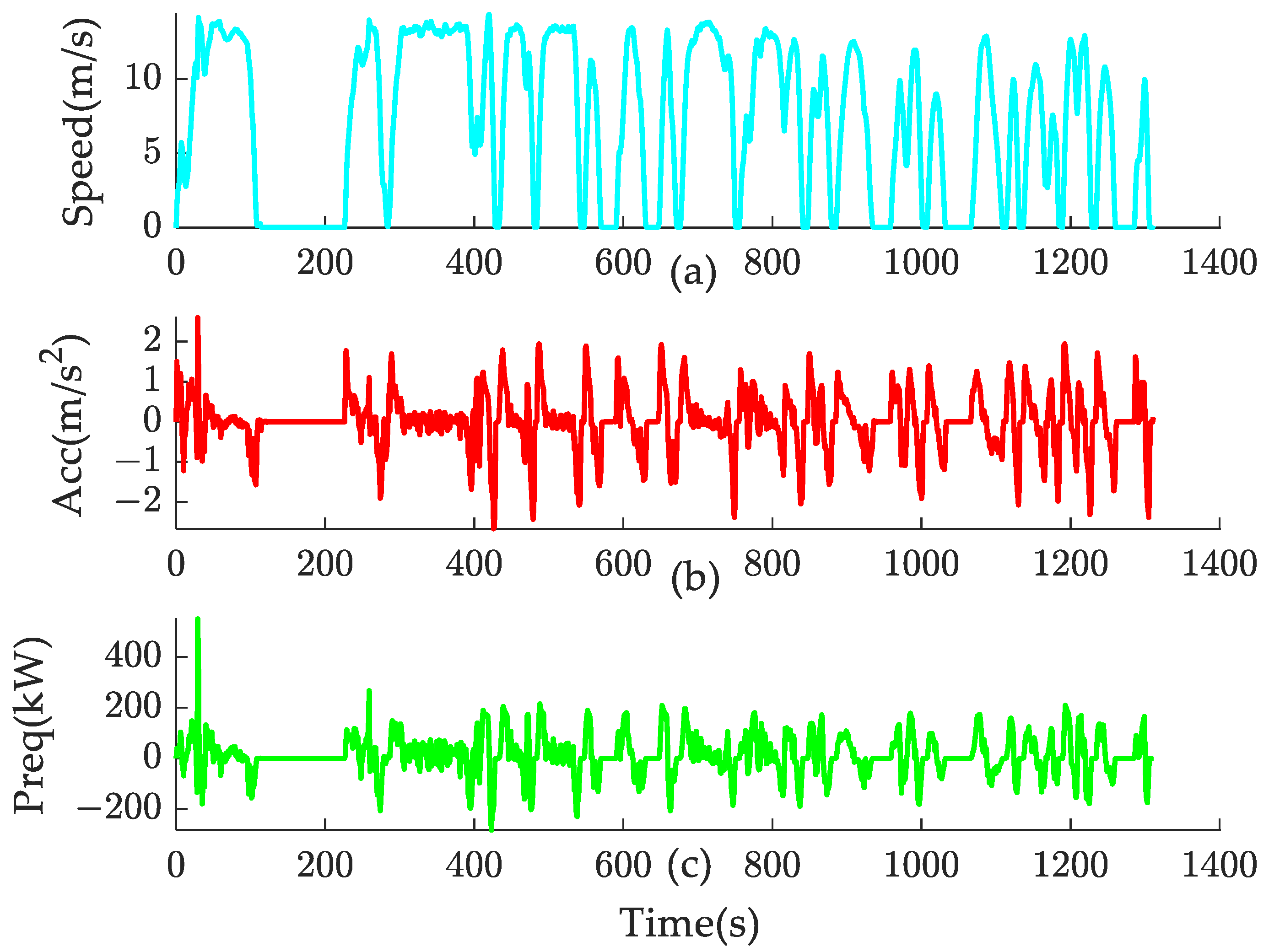
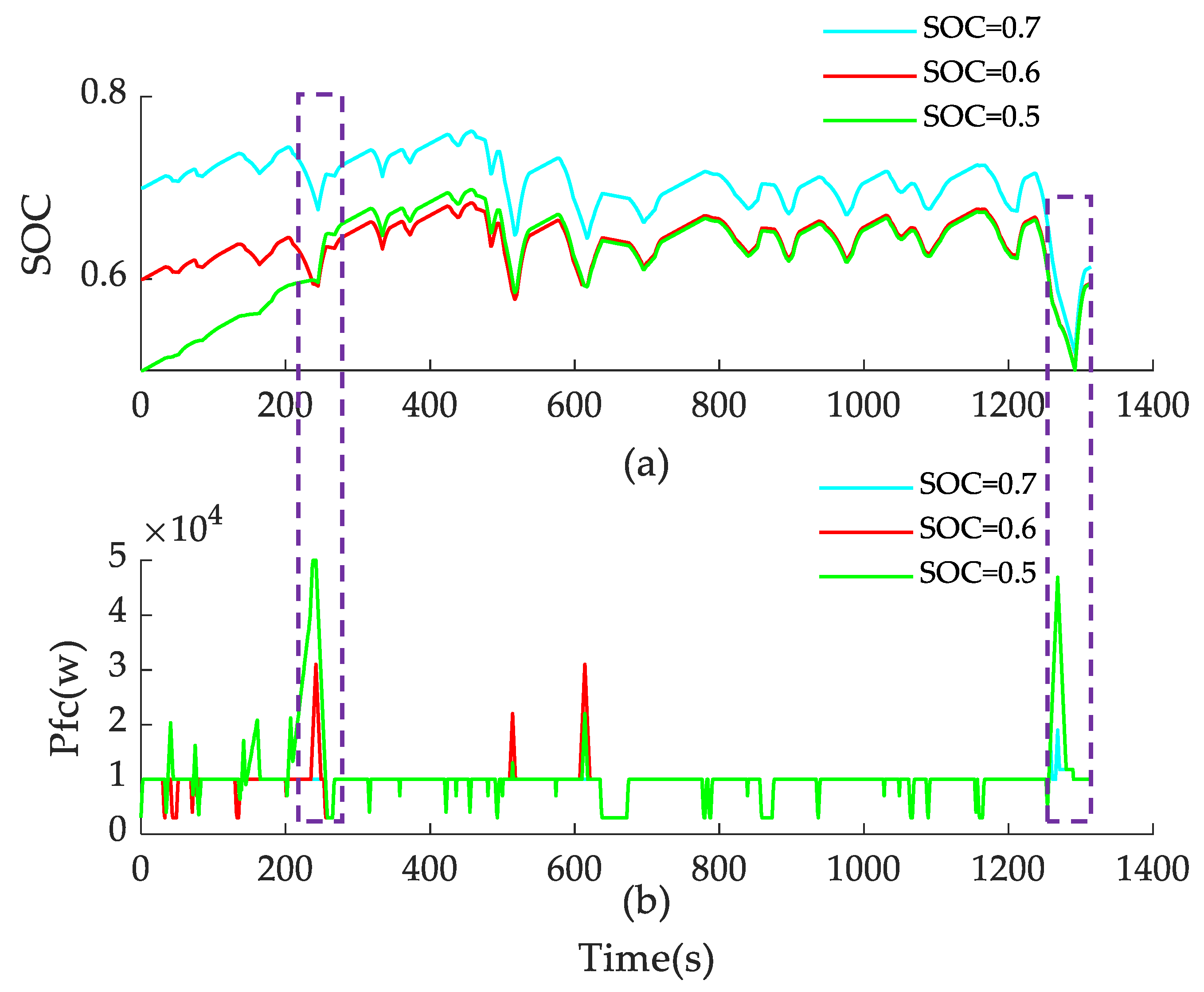

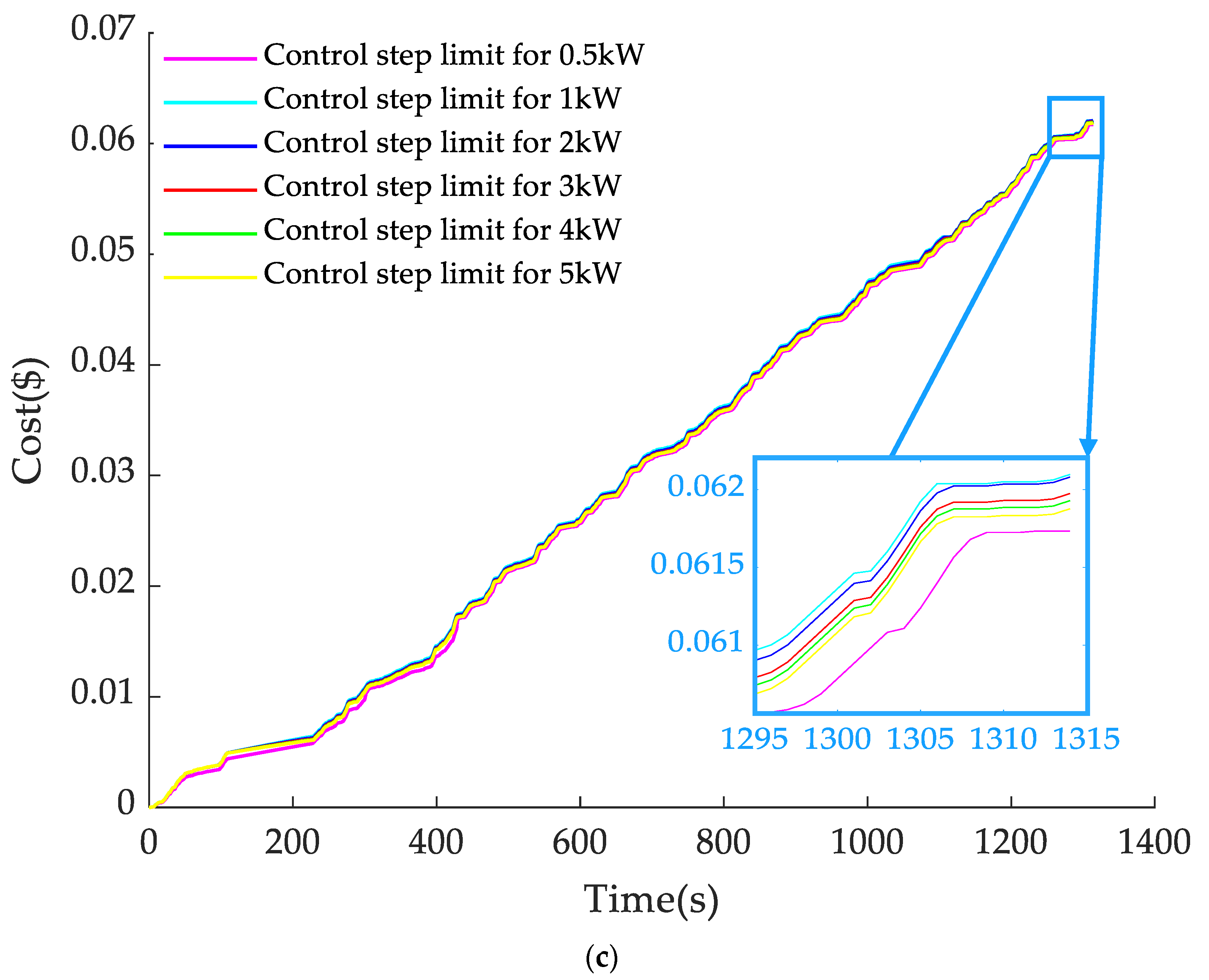
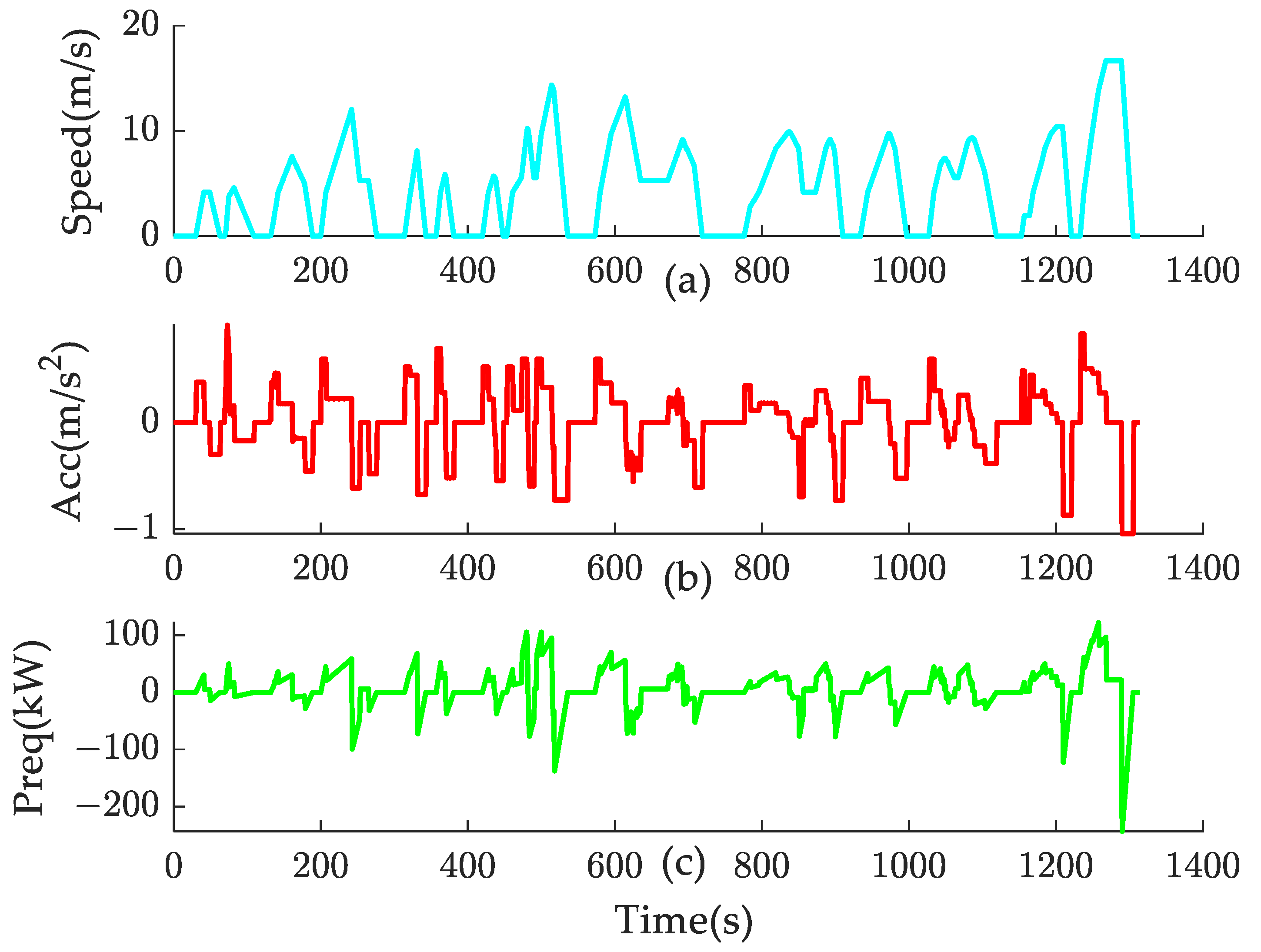


| Category | Item | Value |
|---|---|---|
| Vehicle Parameters | Vehicle mass | 13,500 kg |
| Vehicle front surface | 1.746 m2 | |
| Tire radius | 0.32 m | |
| Rolling coefficient | 0.0135 | |
| Gravitational acceleration | 9.81 m/s2 | |
| PEMFCS System | Rated power | 50 kW |
| Maximum efficiency | 59.6% | |
| Battery System | Nominal energy capacity | 15.18 kWh |
| Others | DC/DC converter efficiency | 0.90 |
| Load | Degradation |
|---|---|
| High load | 10.00 μV/h |
| Low load | 8.662 μV/h |
| Load change | 0.04185 μV/kW |
| crate | 0.5 | 2 | 6 | 10 |
| B | 31,630 | 21,681 | 12,934 | 15,512 |
| Parameter | Value | Unit |
|---|---|---|
| Single fuel cell EoL voltage drop | 6000 | μV |
| Hydrogen price PEMFC stack | 4.00 | USD/kg |
| PEMFC stack price | 93.00 | USD/kW |
| Battery pack price | 178.41 | USD/kWh |
| Cost (USD) | ΔPfc = 0.5 kW | ΔPfc = 1 kW | ΔPfc = 2 kW | ΔPfc = 3 kW | ΔPfc = 4 kW | ΔPfc = 5 kW |
|---|---|---|---|---|---|---|
| CH2 | 0.6476 | 0.6509 | 0.6459 | 0.6491 | 0.6552 | 0.6673 |
| CFC | 0.0535 | 0.0639 | 0.1901 | 0.3639 | 0.3565 | 0.7241 |
| CBAT | 0.0617 | 0.0621 | 0.0621 | 0.0620 | 0.0619 | 0.0619 |
| Ctol | 0.7628 | 0.7769 | 0.9017 | 1.075 | 1.0736 | 1.4533 |
| Cost (USD) | ΔPfc = 0.5 kW | ΔPfc = 1 kW | ΔPfc = 2 kW | ΔPfc = 3 kW | ΔPfc = 4 kW | ΔPfc = 5 kW |
|---|---|---|---|---|---|---|
| CH2 | 0.6276 | 0.6058 | 0.5965 | 0.5932 | 0.5912 | 0.5879 |
| CFC | 0.2525 | 0.2675 | 0.3047 | 0.3455 | 0.3224 | 0.4068 |
| CBAT | 0.0252 | 0.0253 | 0.0257 | 0.0259 | 0.0260 | 0.0262 |
| Ctol | 0.9053 | 0.8986 | 0.9269 | 0.9649 | 0.9396 | 1.0209 |
Publisher’s Note: MDPI stays neutral with regard to jurisdictional claims in published maps and institutional affiliations. |
© 2022 by the authors. Licensee MDPI, Basel, Switzerland. This article is an open access article distributed under the terms and conditions of the Creative Commons Attribution (CC BY) license (https://creativecommons.org/licenses/by/4.0/).
Share and Cite
Li, M.; Liu, H.; Yan, M.; Xu, H.; He, H. A Novel Multi-Objective Energy Management Strategy for Fuel Cell Buses Quantifying Fuel Cell Degradation as Operating Cost. Sustainability 2022, 14, 16190. https://doi.org/10.3390/su142316190
Li M, Liu H, Yan M, Xu H, He H. A Novel Multi-Objective Energy Management Strategy for Fuel Cell Buses Quantifying Fuel Cell Degradation as Operating Cost. Sustainability. 2022; 14(23):16190. https://doi.org/10.3390/su142316190
Chicago/Turabian StyleLi, Menglin, Haoran Liu, Mei Yan, Hongyang Xu, and Hongwen He. 2022. "A Novel Multi-Objective Energy Management Strategy for Fuel Cell Buses Quantifying Fuel Cell Degradation as Operating Cost" Sustainability 14, no. 23: 16190. https://doi.org/10.3390/su142316190
APA StyleLi, M., Liu, H., Yan, M., Xu, H., & He, H. (2022). A Novel Multi-Objective Energy Management Strategy for Fuel Cell Buses Quantifying Fuel Cell Degradation as Operating Cost. Sustainability, 14(23), 16190. https://doi.org/10.3390/su142316190







